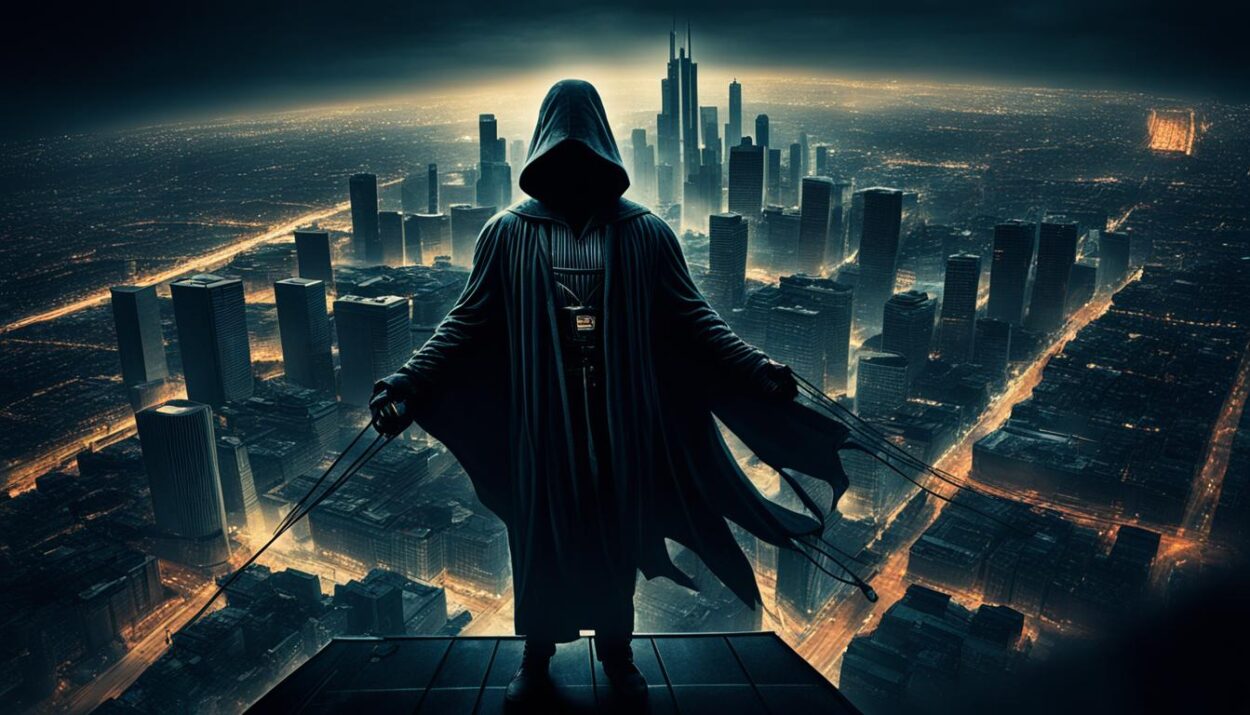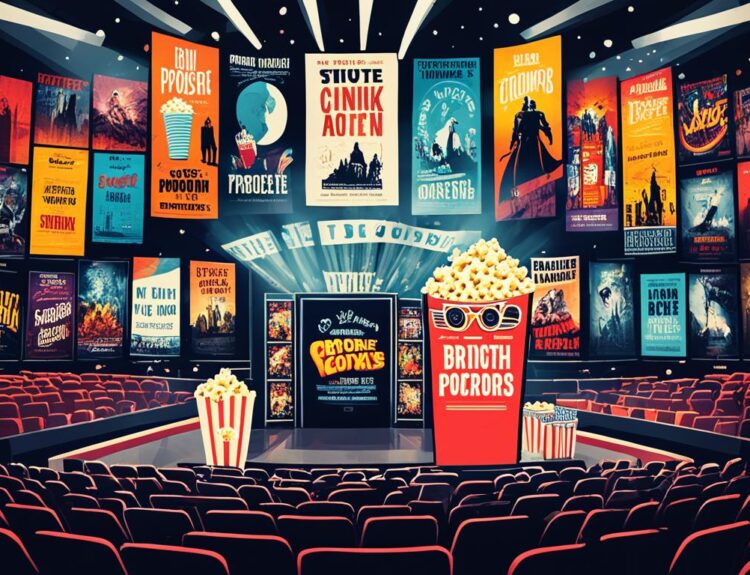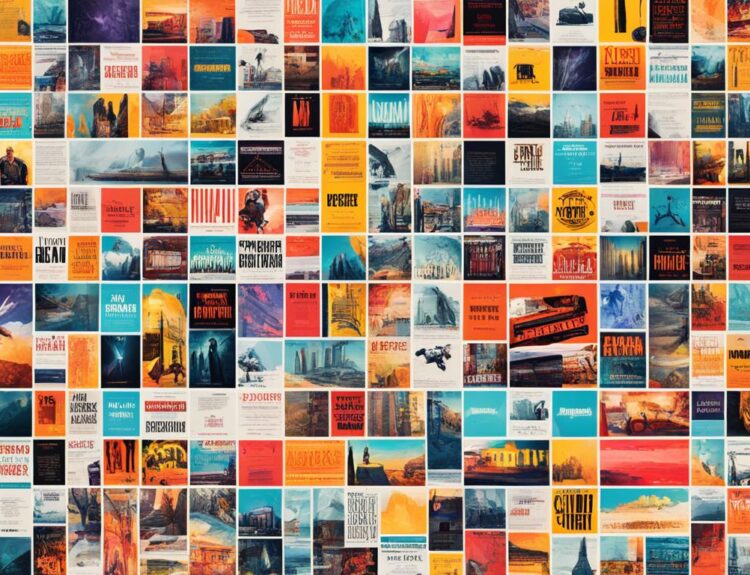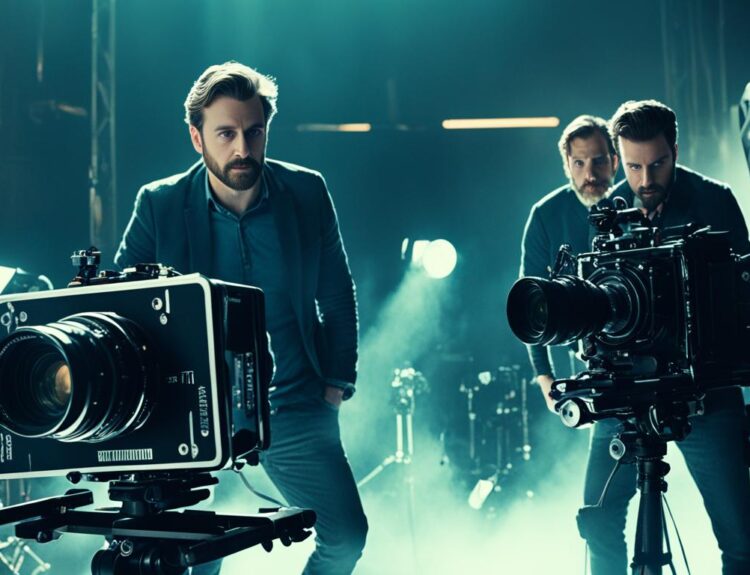The glamorous world of movies often hides a less shiny reality. Behind the scenes, hard work and long hours are normal. Workers, especially during ‘crunch time,’ face tough schedules. This shapes how movies are made and evolve.
Many in the film industry talk about the long hours. The crew of “The Abyss” is one example, working 70 hours every week. This shows the tough side of making movies.
Unions and guilds work hard to make the Hollywood workplace better. They aim to protect the people making our favorite movies. But, the movie business is still very stressful. The push for real-life stories in big films, like “Avatar,” shows our society’s focus on making money. This is a big theme in today’s cinema1.
Key Takeaways
- The film industry’s behind-the-scenes reality often contradicts the glamorous image seen on screen.
- ‘Crunch time’ in film production can lead to excessive working hours and heightened stress.
- Unions and guilds are crucial in regulating workplace practices within the movie business.
- Historical accounts, such as “The Abyss” crew’s grueling 70-hour weeks, exemplify the industry’s demands.
- The evolution of cinema reflects broader societal ideologies and pressures.
The Evolution of Cinema: A Historical Perspective
The history of cinema is an exciting tale of tech advances and key people. It all began with the invention of photography in 1839. This marked a huge shift, replacing simple drawings with photos to create movies2. By 1870, cameras could capture moments quickly, crucial for live action films2. Eadweard Muybridge then made it easier to document fast movements from 1872 to 1877. This paved the way for moving pictures2.
Early Years and Technological Innovations
In the late 1800s, new tech played a big role in film’s early days. Louis Le Prince made the first movie camera in the 1880s. Then, William Dickson enhanced it at Thomas Edison’s labs2. Hannibal Goodwin introduced celluloid in 1887, making films longer and more complex. George Eastman started making it widely available in 18892. The first time the public saw the Kinetoscope was in 1895 in Paris, thanks to the Lumière brothers. This was a big moment for movies3.
Influential Figures in Film History
A lot of big names have shaped cinema through the years. Around 1900, the Lumière Brothers started the commercial film era4. Georges Méliès, their contemporary, made over 500 films. He was a wizard with visual effects and movie making4. Directors like Fritz Lang and F.W. Murnau made masterpieces. Their films like “The Cabinet of Dr. Caligari” and “Nosferatu” were groundbreaking4. Soviet Montage Theory, by Sergei Eisenstein, changed how movies were edited. His work on “Battleship Potemkin” is famous4.
After World War II, film saw new styles like French New Wave and Italian Neorealism. These added fresh perspectives4. Then came New Hollywood in the late 20th century, bringing us blockbuster hits. This era introduced diverse stories and themes4. The Dogme 95 movement focused on simple, real stories. It stood out against typical Hollywood films4. All these changes and new ideas have deeply influenced the film industry.
Movie Production Costs: A Deep Dive
Understanding movie production costs is key. This is especially true when we look at big-budget films vs. indie movies. As we explore budget details, we often find hidden costs. These can change a movie’s financial picture a lot.
Budgeting for Blockbusters vs. Independent Films
Big movies need lots of money. They pay for famous actors, top-notch special effects, and big marketing drives. Films like those in the Marvel and Star Wars series spend more. They use worldwide ads and the latest effects.
Indie films, on the other hand, work with smaller budgets. They focus on storytelling and new ways of making movies. These filmmakers might have about $25,000, which is tiny compared to big productions that might spend over $300,0005.
Hidden Costs in Film Production
Hidden costs can pop up later, affecting both big and small film budgets. An example is “Sonic the Hedgehog,” which had to change things up based on what viewers wanted. This cost extra money.
Paying for visual effects, music, and reshoots can add extra challenges and costs. Sometimes, unexpected needs like additional CGI or last-minute changes can push budgets over the edge. Makers need to plan carefully and be ready to adjust.
| Expense Category | Blockbusters | Independent Films |
|---|---|---|
| Cast | High-profile, multi-million contracts | Limited, often unknown actors |
| Special Effects | Advanced CGI, costly | Practical effects, minimalistic |
| Marketing | Global campaigns | Local and social media-based promotions |
Big movies spend a lot on various things. Indie cinema, though, gets creative with how it uses money. This difference shows how the industry meets what different audiences want.
Film Distribution Models: Traditional vs. Modern Approaches
The world of film distribution has changed a lot over time. We moved from showing films only in theaters to watching them on digital and streaming platforms. This big change has influenced what audiences prefer to watch. The COVID-19 pandemic played a big role in this shift too.
The Role of Theaters in Film Distribution
In the past, theaters were very important in the film industry. They shared the money they made with the film distributors. This sharing could change, depending on their deals. Even with digital platforms becoming popular, theaters are still key for big movies. That’s because they offer an unmatched experience with their visuals and sound.
Now, to keep up with what audiences want, some movies get released in theaters and on digital platforms at the same time. This approach helps reach more people. But, it could also affect how much money theaters make.
The Rise of Digital and Streaming Platforms
Streaming services have changed the game in how movies are distributed. Companies like Netflix and Disney+ pay a set price for the rights to show movies exclusively. This deal works well for films with medium budgets or specific audiences. For example, in 2022, Netflix had 200 million subscribers and spent about $5.8 billion on new shows and movies.
Amazon Prime Video and Disney+ are doing something similar. Amazon spent $7 billion, and Disney spent $10.5 billion on new content in 2022. These big investments show how important streaming has become in the movie world.
Now, filmmakers are looking at ways to use both traditional and digital methods to share their movies. This approach helps them make more money and reach more viewers. It fits well with how people’s watching habits are changing and the challenges we face, like the pandemic. Filmmakers with less money can also benefit from this because technology allows them to create good movies without spending a lot.
Digital platforms have led to different ways to watch movies and shows, like TVOD, SVOD, and AVOD. Through these options, viewers can choose how they want to access content. As stories start to blend different genres and not follow a strict line, streaming services offer a place for creative and impactful films.
Box Office Trends: Pre and Post-Pandemic
Box office trends have changed a lot from pre- to post-pandemic times. This reflects big changes in how people watch movies and their habits. Before the pandemic hit, North American box offices sold a strong 1.2 billion tickets7. But the pandemic caused a huge drop, with 2022’s North American box office making just $7.4 billion7. Despite this, there’s hope for the film industry. Theater ticket sales went up to 492 million in 20217, showing a slow but sure recovery.
AMC Theatres, the biggest cinema chain in the U.S. and Canada, saw its revenue drop to $4 billion in 20227. But the second quarter of 2023 brought some good news. Global revenue rose to $1.35 billion, a 15.6 percent increase from 20227. Yet, Canadian theaters faced a downturn, making just over $250 million USD, showcasing regional recovery differences7.
Streaming platforms have become a major player in changing how we watch movies. The move to watching from home has challenged the traditional movie theater scene. The pandemic only pushed this trend further. Now, more people are investing in at-home entertainment, like streaming services.
The movie theater industry is trying to adjust to these challenges. The biggest four companies in the U.S. now share the market, hinting at potential mergers and strategic changes8. Teenagers, especially those aged 12 to 17, are key moviegoers, attending an average of 2.5 movies in theaters in 20217. This shows a demographic that could shape future movie-watching trends.
| Period | North American Box Office Revenue | AMC Revenue |
|---|---|---|
| 2022 | $7.4 billion | $4 billion |
| Q2 2023 | – | $1.35 billion |
The road to recovery for the movie industry is not simple. It’s a mix of dealing with ongoing pandemic effects and adapting to new ways of movie watching. The big question is whether these changes are temporary or if they mark a complete change in Hollywood.
Audience Demographics: Who’s Watching What?
It’s key to know who watches what. This tells us about their likes and what’s popular. Age, gender, and where people live play a big part in choosing shows or movies.
Changing Preferences and Viewing Habits
Recent data shows that streaming sites like Netflix change how different groups watch TV. The show “Squid Game” got over 13 million watching minutes, mainly from people 18 to 34 years old9. This shows young folks like new and global stories. “Lucifer” reached over 18 billion minutes watched. It’s a hit with women and loved by all ages9.
Now, 73% of U.S. homes have Netflix, showing wider viewer types9.
Impact of Age, Gender, and Location on Movie Preferences
Age impacts how often people go to movies. Half of those 18 to 34 go often or sometimes, while 45% of 35 to 44-year-olds do the same10. But, 30% of people over 65 hardly ever go to theaters10.
Gender influences movie habits too. 46% of U.S. men often go to movies, unlike 37% of women10.
Movies liked can vary by city or countryside. Cities enjoy a mix, but rural areas choose traditional or family films10.
Money matters in movie-going. Those making over 100 thousand dollars a year often go to movies 53% of the time. This drops to 36% for earners under 50 thousand dollars10.
Lastly, race plays a role in who sees movies. In 2017, 55% of movie tickets were bought by white people. Hispanic moviegoers were 23%, Black audiences 12%, and Asians 7%10.
Streaming Platform Impact on the Movie Industry
Streaming platforms have changed how we watch movies. People are choosing to watch at home more than going to the theater. This big shift has made streaming very popular.
The Shift from Theaters to Home Viewing
In 2018, about 28% of movie-goers preferred the theater for first-time viewings. By 2020, only 14% stuck with theaters, while 36% chose streaming11. Streaming became more popular quickly, especially during the pandemic. Many theaters shut down, causing a huge loss. This pushed people to stream movies on services like Netflix and Hulu11.
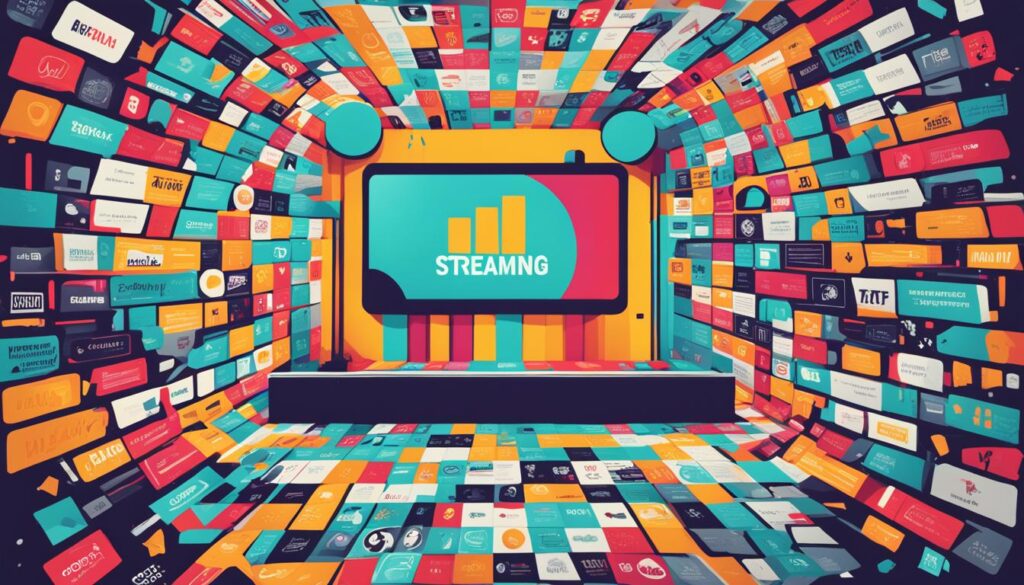
Subscription Models and Revenue Generation
Streaming services use subscription models to make money. They are more affordable than theater tickets. For example, a movie ticket costs around $10.45 but a basic Netflix subscription is only $6.9911. This good deal attracts lots of subscribers.
Netflix plans to make more original shows and movies. By 2027, they want all their content to be original11. Originals help keep subscribers interested and help Netflix make more money.
Streaming has greatly affected the movie industry. It offers what viewers want, changing the industry with new models and lots of content. For more information, you can read about streaming platforms and their impact on the film industry.
Film Marketing Strategies: Past and Present
Film marketing has drastically changed over time, moving from old ways to the digital world. Understanding these shifts helps us learn how to make a film more successful. It shows what works best to get a film noticed and make money.
Traditional vs. Digital Marketing Techniques
In the past, movie studios mostly used TV to advertise, dedicating over 82% of their budget to it, while only 10% went to digital marketing12. Yet, digital ads were found to be three times better at increasing profits12. This shows the rising value of digital promotion in current movie marketing plans.
For action movies rated PG-13, studios in the U.S. typically spend $30 million on marketing, mostly on TV and magazines12. Moving just 10% of this budget from TV to online videos could boost sales by 16%12. Online videos are a key way to engage audiences and get a better return on investment.
The Role of Social Media and Influencers
Today, social media is crucial in marketing movies. Platforms like Instagram, Twitter, and YouTube help studios connect with fans in a real way. Influencers and social media campaigns are great for promotion because they reach many people fast.
Spreading ads across different channels could raise profits by 34%, adding $15 million for a typical PG-13 action movie12. This not only shows the move to digital but also the power of using various media to make a bigger impact.
Even though online video ads make up only 4% of all U.S. ads for movies, they bring in 16% of the profits12. This big difference proves that videos are excellent at grabbing attention and making money, showing their importance in today’s film marketing strategies.
Movie Industry Insights: What We Learn from Data
Today’s movie industry relies heavily on data. This approach helps understand what viewers like and how to succeed in the market. By analyzing data in film making and sharing, the industry learns valuable lessons. For example, each year, movies lose $40-$97.1 billion because of piracy. This big loss makes it clear why it’s so important to have strategies that use data13.
Blockchain technology is also becoming very important. It could make sharing movies cheaper, remove middlemen, and give creators more control over their work13. This new method is making things more efficient and safer. Having good security and clear records is very important for handling movie rights and deals13.

The movie world is growing fast thanks to more diverse stories14. Movies from different countries are reaching more people. This gives great insights into what audiences around the world enjoy14. By understanding what people like to watch, creators can make movies that resonate with viewers.
When making a movie, using data is crucial at every step14. While big companies have lots of money and resources, smaller ones use data to find and appeal to specific audiences14. This smart use of data helps everyone in the movie world navigate its challenges successfully.
Data is leading the way to a sustainable future for movies14. As the industry uses more analytics, making smart, informed choices is becoming more crucial than ever.
The Role of Film Festivals in Promoting Movies
Film festivals greatly help in promoting movies. They offer a special platform, especially for independent films. In 2023, film festivals have embraced digital platforms. This makes it easier to find and enjoy different stories. Indie filmmakers now have a chance to share their work with the whole world1516.
Importance of Prestigious Film Festivals
Prestigious events like Cannes, Venice, and Berlin are very influential in the movie industry. The Venice Film Festival started in 1932. It was the first ever and has led the way for others like Cannes, which began in 1946, and Berlin, which started in 195116. These events are key for indie filmmakers. They can gain recognition and show that their films are important. This helps audiences and people in the industry notice their work15.
Opportunities for Independent Films
Film festivals are very important for independent film exposure. They choose films that often set the trends in global cinema. This brings out new ideas and inspires indie filmmakers16. Moreover, networking at festivals helps filmmakers make important contacts. These connections can lead to collaborations that help their careers grow15.
Being a part of film festivals can win indie filmmakers awards. This makes them stand out to people in the movie business15. Also, getting a distribution deal at these events is key. It lets their films reach more people and earn money. This makes film festivals very important for indie filmmakers who want to succeed15.
| Festival | Founded | Significance |
|---|---|---|
| Venice Film Festival | 1932 | First film festival, sets industry standards |
| Cannes Film Festival | 1946 | Significant global cinema trendsetter |
| Berlin International Film Festival | 1951 | Vital platform for showcasing diverse cinema |
In summary, film festivals around the world are crucial. They give independent films exposure and help filmmakers network. This is essential for anyone in the competitive film industry wanting to succeed1516.
Behind the Scenes: The Reality of Long Hours and Crunch Time
Film production often involves long hours and crunch times. These pressures can harm the well-being of cast and crew members. Tight deadlines and the quest for perfection mean little room for mistakes. This leads to schedules where VFX artists might work 60-80 hours or more during crunch times17. Many VFX professionals also face job instability because they work on a freelance basis17.
Impact on Cast and Crew
The demanding hours of production crunch risk the well-being of the cast and crew. Strikes by SAG-AFTRA and the Writers Guild of America have stopped productions. They’ve greatly affected the financial and health status of crew members. For example, John Campbell, a veteran grip and driver, lost his health insurance by missing 400 qualifying hours by just 7.5 hours17.
Bill Bridges, a 54-year-old grip, has unpaid bills due to the strikes18. These hard work conditions lead to higher stress and depression among crew members18.
Union Regulations and Workplace Conduct
Unions play a crucial role in keeping workplaces fair for cast and crew. However, VFX artists often don’t get paid extra for overtime, causing dissatisfaction17. The Motion Picture Industry Pension and Health Plans set tough standards for health insurance. Crew members must work 400 qualifying hours in six months, a hard goal during strikes18.
Crew members have to find other ways to make ends meet. They work on non-AMPTP productions, take freelance jobs, and even start side businesses18.
| Challenges | Current Scenario | Impact on Well-being |
|---|---|---|
| Long Work Hours | 60-80 hours during crunch times17 | Increased stress, fatigue |
| Freelance/Contract Work | High job instability17 | Mental health issues, financial struggles |
| Lack of Overtime Compensation | No additional payment for extra hours17 | Employee dissatisfaction, burnout |
| Health Insurance | 400 qualifying hours required in six months18 | Loss of coverage, increased anxiety |
The industry needs to do more to support crew members, especially during disputes. Despite the challenges, the cast and crew’s resilience and unity show their commitment to their art18.
Industry Regulations and Standards
To make sure a film set runs well and is safe, strong regulations and standards are a must. Changes in the movie industry due to strict safety rules set by unions and guilds have kept everyone safe.
Unions and Guilds: Guardians of Safety
Groups like the Screen Actors Guild have been key in raising safety levels. The Occupational Safety and Health Administration’s safety plans have cut set injuries by 20%19. Also, drone tech has led to 30% fewer accidents in the air, says a study by the Cinematographers Guild19.
Technological Advancements in Safety
New tech has made film sets safer. Robotic cameras now do 40% of dangerous shots, reducing risks19. Virtual reality has also cut stunt injuries by 25%19. Beyond physical health, mental health support in the industry has grown by 40% since 201919.
Regulatory Improvements and Their Impact
In California, better rules by Cal/OSHA have lessened safety breaches on sets by 18%19. The Motion Picture Association noticed a 15% fall in set accidents since 2018, thanks to necessary safety training19. Efforts to tackle workplace stress have cut stress-related problems by 30% among workers19.
Learn more about safety progress in films by checking out this detailed guide.
FAQ
What are the common challenges faced within the film industry?
How has cinema evolved over time?
What are the differences in budgeting for blockbusters versus independent films?
How have modern technologies changed film distribution models?
How has the pandemic impacted box office trends?
What do audience demographics reveal about movie preferences?
What impact do streaming platforms have on the movie industry?
How have film marketing strategies evolved over time?
Why is data analysis important in the movie industry?
What role do film festivals play in promoting movies?
What are the behind-the-scenes realities of long hours in film production?
Source Links
- https://medium.com/@ben.davies2001/the-film-industrys-battle-with-capitalist-realism-d60e0a24adcc
- https://www.britannica.com/art/history-of-the-motion-picture
- https://www.scienceandmediamuseum.org.uk/objects-and-stories/very-short-history-of-cinema
- https://www.studiobinder.com/blog/the-history-of-film-timeline/
- https://joshua-caldwell.medium.com/short-films-are-a-giant-waste-of-your-time-and-money-3b134cfb1b9b
- https://www.linkedin.com/pulse/exploring-film-distribution-models-entertainment-business-lemarco
- https://www.visionmonday.com/business/research-and-stats/article/north-american-box-office-makes-post-pandemic-recovery/
- https://www.ibisworld.com/united-states/market-research-reports/movie-theaters-industry/
- https://www.nielsen.com/insights/2022/streaming-grew-its-audience-in-2021-drama-reality-and-kids-programming-lead-the-content-wars/
- https://www.gruvi.tv/post/movie-audience-demographics/
- https://blog.filmtrack.com/industry-insights/streaming-platforms-and-their-impact-on-the-film-industry
- https://www.forbes.com/sites/forbesinsights/2015/07/01/8-insights-on-how-marketing-drives-movie-box-office-sales/
- https://blog.filmtrack.com/industry-insights/the-role-of-data-and-technology-in-film-finance-and-licensing
- https://ro-bust.co.za/how-would-you-describe-the-film-industry/
- https://www.blog.thefilmfund.co/the-importance-of-film-festivals-what-they-offer-for-filmmakers/
- https://filmnet.io/every-question-you-have-about-film-festivals-answered-everything-you-need-to-know/
- https://www.linkedin.com/pulse/from-life-pi-bankruptcy-unstable-reality-vfx-artists-hollywood
- https://www.linkedin.com/pulse/crunch-time-film-crew-backbone-industry-carolyn-d-pitt-esq-
- https://ciolook.com/how-the-movie-industry-is-advancing-new-safety-standards/
